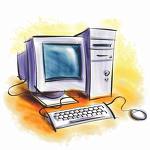Portable Devices
Portable devices run the gamut from cell phones to laptops. Here are some products and guidelines to make these items easily accessible and keep them in top condition.
Charging Stations
Charging stations are part of the latest wave of products designed to help keep cell phones, iPods and PDAs organized and ready to go! In order to maximize the benefits of a charging station, keep these guidelines in mind:
Make sure the station has enough compartments for all your devices.
Place the charging station in the area of your home where you can most easily access your electronics. You will likely be grabbing these items on-the-go, so location is key.
Choose a design that complements your home or office décor.
Pre-made stations are available locally at Pottery Barn and occasionally at big box retailers. For less expensive but equally beautiful options, visit www.kangaroom.com or www.containerstore.com.
If you are a do-it-yourselfer, you can create your own charging station with items available at craft and big box retailers. To do this project, you will need the following items:
A simple cardboard box or photo box, lined with foil
Paper or fabric to line the outside of the box, if you start with a plain cardboard box
Double stick tape or a glue gun
Thin elastic
Book plates (for labels)
Cardstock (for labels)
Brads (to attach the book plates to the box)
A power strip with surge protection
Velcro wraps, cable turtles (see explanation below) or twist ties to shorten cord lengths
Cord labeling supplies (Kableflags [see explanation below], labeler labels, masking tape and a Sharpie)
A drill (if you are using a photo box)
An Exacto knife (if you are using a cardboard box)
Directions
1. Line your box with foil.
2. If you use a cardboard box, cut slits wide enough at the back of the box for charger heads to go through. Also cut an opening for your power strip cord. If you use a photo box, you can either cut or drill similar wholes at the back of the box for charger heads and your power strip cord.
3. Cover your box with paper or fabric. Use your Exacto knife or scissors to cut slits that will allow charger heads to pass through.
4. At desired intervals along the top of your box, glue elastic pieces or loops to hold your charger heads/cables in place.
5. Affix your book plates to the front of the box with brads or another fastener of your choice. These will act as your label holders.
6. Create hand-written or computer generated labels for your devices. Insert them in the book plates.
7. Insert your charger cables through the designated slots and secure to the top of the box through the elastic loops.
8. Label each cable near the plug.
9. Plug each item into the surge protector and use Velcro wraps or twist ties to shorten cord length.
10. Plug in the surge protector, and off you go!
Travel Pack
If you travel frequently, either for business or for pleasure, create a “travel pack.” A travel pack is also a wonderful way to prepare your technology if you do presentations or have to frequently transport technology between home and office.
A travel pack should contain duplicate chargers and any other additional cords or cables that could possibly get left behind. My favorite containers for this kind of application are mesh pouches, available locally at Barnes & Noble (2100 So. and 5300 So. locations) and online at www.containerstore.com. You can use the small size pouches for flash drives, your wireless mouse and its USB connector and batteries. The large size pouches are ideal for chargers, cords, USB cables, etc. The large size pouches are also wonderful for keeping all the separate smaller pouches together!
Stationary Devices
Stationary devices include your desktop computer, printer, scanner, UPS, speakers, etc. There are some specialized organizing solutions for these home and business office staples.
Cord and Cable Management
Cord and cable management is a huge technology organizing issue. The following link will connect you to an entire article detailing several cord and cable management solutions:
http://studio5.ksl.com/index.php?nid=59&sid=2710628
In addition to the solutions given in the above article, the Cable Manager kit available at www.cable-safe.com will help you manage large numbers of cords and cables, both at home and at work. The Cable Safe company boasts clients as illustrious as Yale and Columbia Universities as well as Apple, IBM and Wells Fargo. There are also thousands of home office users who have found great success with Cable Safe’s cable management products. Here’s a before and after teaser highlighting Cable Safe products. What a difference the right tools make!
Placement
Placement is another issue in organizing technology. Some quick tips to make placement work for rather than against you are these:
Make sure common use items are in easy reach of all users. If you have only one printer or fax machine in the home or office, don’t put it in your personal workspace; you’ll set yourself up for interruption after interruption!
Consider your equipment’s heating and cooling requirements. For example, keep your towers away from heating/cooling vents to avoid temperature extremes and to protect from dust.
Use heavy duty wire shelving to house electronic components in order to increase circulation.
Consider lifting towers up off the floor by using heavy duty wire shelving or products like those in the Cable Safe example above.
Passwords and Codes
If you’ve ever had to reset usernames or passwords because you’ve forgotten them, you know how frustrating the process can be. To avoid the situation entirely, record your passwords and access codes. Two of the simplest ways to do this are to—
Store the passwords in an Excel file.
Keep an updated list in your filing system or planner if you are concerned about your computer be hacked or the file being discovered.
Recycling, Disposal and Donation
One of the primary activities of organizing is determining which items to keep, donate, throw away or recycle. With electronics, there are specific recycling and disposal guidelines because of the hazardous materials found in these items. To lessen environmental impact when disposing of electronics, there are a number of local companies and retailers that can help.
Recycling Companies
GRX Recycles (GRX is the contracted recycling center for the State of Utah.)
Location: Clearfield, UT
Web Site: www.grxrecycles.com
Contact: Eric Anderson, (801) 386-2533
Items Recycled: ALL electronic devices (e.g. TVs, computers, cell phones, virtually anything that plugs into a wall)
Cost: Pricing varies and is available at the GRX web site. Pick-up is available for an additional fee, which varies according to items and location.
Additional Information: GRX and the State of Utah are planning a technology recycling event for May or June of 2008. The cost of recycling at this event will be reduced, so stay posted for more details!
Lucency Corp.
Location: 1532 South 1900 West, Salt Lake City
Web Site: None
Contact: Billy, (801) 364-4733
Items Recycled: Electronics minus appliances and microwaves
Cost: 15 cents per pound
TransJordan Landfill
Location: 10873 South 7200 West, South Jordan
Web Site: None
Contact: Amy or Esther, (801) 569-8994
Items Recycled: Home computers and peripherals, batteries
Cost: Free
Local Retailers
Best Buy
Location: Various
Web Site: www.bestbuy.com
Items Recycled: Cell phones, batteries
Cost: Free
Office Depot
Location: Various
Web Site: www.officedepot.com
Items Recycled: Home computers and peripherals, batteries, ink and toner cartridges
Cost: Home computers: $5-15; batteries: free; ink and toner cartridges: $3 credit per cartridge, depending on type
Staples
Location: Various
Web Site: www.staples.com
Items Recycled: Home computers and peripherals, cell phones, batteries, most other small electronics, ink and toner cartridges
Cost: Home computer: $10; other items: free; ink and toner: $3 credit per cartridge, depending on type
Additional Information: Staples is the only office supply retailer that guarantees that your hard drive will be wiped clean according to Department of Defense standards. At Staples, you also receive a tracking number when you ship a computer to be recycled.
Donations
Donations of used electronics are best determined on a case-by-case basis with the agency of your choice.
Happy Organizing!















Add comment